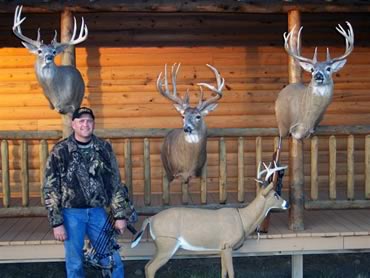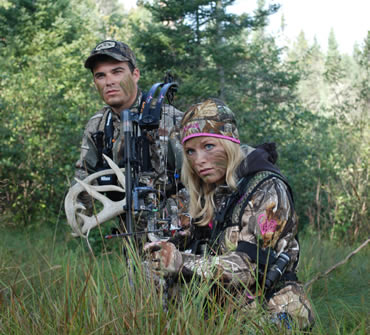The more deer concentrate in a small area, the better your chances of tagging one.
As browsers, whitetails are constantly on the move from one food source to another. They’re also creatures of habit, sticking to areas and trails that have provided safety and security in the past.
Every year, hunters successfully pattern and kill individual bucks by setting up on their preferred travel routes. Not everyone has the time, resources and access to unpressured ground that make patterning individual bucks possible, however.
For most of us, that means focusing on locations where deer movement is focused: funnels. A funnel is anything that encourages or forces deer in a given area to use a particular trail.
There are natural funnels, man-made funnels, obstacle funnels and enticement funnels, but all create the same outcome by pushing lots of deer into a small area.
The more deer move through a given area, the better your odds of putting a tag on one. And for bowhunters, funnels help ensure the buck you see will be within range.
The problem is finding a good funnel. Some funnels are used regularly, while others are affected by variables like wind, vegetation and food sources. Then there are funnels that get used like the D.C. Beltway.
Before you go looking for a Beltway funnel, think about why deer use them.
One of the biggest reasons is whitetails, like humans, tend to be lazy. Why would a deer travel through the middle of a thicket if it doesn’t have to? Why would it swim across a raging river if it could walk across a shallow stream? Why would a deer travel down a deep embankment if it could walk along a high ridge? Just like us, deer typically take the path of least resistance.
Deer Are Deer
Mick Bowman knows a lot about funnels and how to hunt them. Bowman is a pro-staffer for Knight & Hale Game Calls and Summit Treestands. He grew up in Missouri hunting near ravines and rivers. Now he hunts on the Kansas prairie.
Hunting funnels in multiple states with verying terrain might seem different, but the principles are the same.
“What I have learned from hunting in Missouri and Kansas is deer are still deer,” he said. “They always use the terrain to keep concealed and to get where they are going without wasting energy.”
Bowman is always on the lookout for a ravine or a series of ravines where bucks can travel in daylight without being seen.
“My favorite stand is right where four ravines come together like a big intersection,” he said. “Deer use those areas to travel between bedding areas and feeding areas which, in this part of the country, are crops like corn or soybeans.”
 Water Funnels
Water Funnels
Most funnels are formed by a natural barrier, and water is one of the best.
In Missouri, Bowman says he liked to hunt near the edge of a river.
“Deer often stick close to the water’s edge so they can get a drink while traveling,” he said. “Plus, high banks create a secure place for them to travel without being seen. When hunting near water, I like to set up near a shallow spot where deer cross.”
Whitetails rarely let any body of water keep them from going where they want to go, but they don’t swim farther than they have to.
“Deer most often cross at shallow spots or sandbars in a river so they don’t have to go swimming,” Bowman said. “I sometimes walk along a river for a long way to find the perfect spot. Look for a deep ravine that’s evident on both sides, along with some cover to keep deer hidden. If it’s a funnel they use often, the bank will be beaten down from all the tracks. I like to hang a stand within bow range of such crossings.”
Technology
Another way to find funnels is through technology. Google Maps and TerraServer are a couple online tools you can use at home.
Steven Crooks from Michigan often hunts in farm country that borders large chunks of public ground. Michigan is known for having lots of hunting pressure, so when a lease came up for an 80-acre tract that bordered a large piece of public ground, he jumped on it after seeing the obvious funnel on his computer.
“Deer know where public and private ground is,” Crooks said. “When the hunting pressure increases on the public ground, deer spend a lot of time on private property, even if it’s small.”
That Crooks’ parcel isn’t very big and doesn’t have much cover was a positive. “Before I leased the property, I looked on Google Maps,” he said. “I could practically see the runways going through a thin strip that connected a bedding area in the hardwoods with corn and soybean fields nearby. With the public land and crops nearby, I knew deer were going to use that thin strip of forest. It had a thick swale on each side, and I was sure they would use that funnel to avoid being seen.”
Proof Positive
Crooks was right.
While he was hunting the funnel a few years ago, a 134-inch 10-pointer walked right down the middle.
“The nice thing about the funnel is that it’s less than 50 yards wide,” he said. “I find extremely narrow funnels are the most productive. When a buck walks into one, he is typically within bow range. It’s also easier to get pictures of bucks in narrow funnels.”
Crooks had several pictures of the buck on his camera before he shot it. And the story gets better.
“Twenty-four hours after I killed the 134-inch buck, I climbed into the same stand in the dark. I could already hear three different bucks in the funnel. Shortly after daylight, a 138-inch 10-pointer was standing right in front of me. I let an arrow fly, and the rest is history. I tagged two nice bucks in 24 hours on a tiny piece of property.”
 Fence Line Bucks
Fence Line Bucks
Bowman hangs fences for a living and knows how well a fence line creates a funnel.
“Deer have no problem jumping a fence, but they often travel a fence line between one spot and another,” he said. “If they run into trouble, they can quickly hop the fence and get away.”
Where fence lines turn into major funnels is when they transition into heavy cover or a deep ravine.
“The more features a piece of property has that allow a deer to move freely between their bedding area and feeding sources, the more likely it is deer will run that area.”
Fence lines connecting areas of security cover can be magical.
Funnels Can Change
Bowman is quick to point out that funnels can change in the middle of hunting season.
“When cold weather makes the leaves fall and vegetation dies, deer sometimes move to a different funnel where the topography allows them to remain concealed,” he said. “When does come into estrus in a given bedding area, bucks often begin using different travel routes to keep an eye on them. I like to have multiple stands set up so I have other options if things change. Crops like corn can be funnels until they’re harvested. A hunter who anticipates that change can take advantage of the situation.”
Wind direction is another unpredictable factor, so Bowman creates several setups where he’ll have a stand to hunt regardless.
“Deer will use a funnel differently when the wind blows a certain way,” he said. “Over the course of many years of hunting the same areas, I have determined how deer use certain funnels based on crops, wind and natural vegetation cycles. Funnels really become productive when you get to know an area and what about it motivates the deer.”
Candid Cameras
Finding funnels requires work, but anyone can do it, especially with the technology available.
“I suggest you buy a few scouting cameras and use them,” Bowman said. “I have cameras out all the time, both at known funnels and other spots that have potential. A spot that wasn’t a productive last year might be a great funnel this year if a farmer changes his crops, if an acorn drop is particularly good or if a forest is timbered. A great funnel can also go bad if trees are cut or if something else changes that causes the deer to seek a better path.”
Do It Yourself
If you know where deer are feeding and bedding, you can create a funnel with a little elbow grease.
“It isn’t very difficult to cut a few trees or move some brush around to alter deer patterns,” Bowman said. “I have done so many times. By moving brush around, I can force the deer right by my stand.”
Read Recent Articles:
• On the Edge: Use observation stands to figure out deer movement before you move in for the kill.
• Droopy, not Droppy: Sometimes Plan B works out even better than Plan A.
This article was published in the October 2014 edition of Buckmasters Whitetail Magazine. Subscribe today to have Buckmasters delivered to your home.